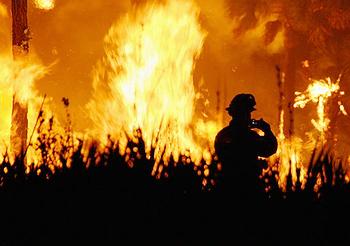
GENEVA, Switzerland, July 17, 2013 (ENS) – The first decade of the 21st century was the warmest decade recorded for both land and ocean surface temperatures since modern measurements began around 1850, finds a new report by the World Meteorological Organization.
More national temperature records were reported broken than in any previous decade, according to the report, “The Global Climate 2001-2010, A Decade of Extremes.”

“A decade is the minimum possible timeframe for meaningful assessments of climate change,” said WMO Secretary-General Michel Jarraud, who oversees the United Nations agency with 191 member states and territories.
“WMO’s report shows that global warming accelerated in the four decades of 1971 to 2010 and that the decadal rate of increase between 1991-2000 and 2001-2010 was unprecedented,” he said.
The WMO report is based on findings from a unique survey of 139 National Meteorological and Hydrological Services and socio-economic data and analysis from several UN agencies and partners.
“Rising concentrations of heat-trapping greenhouse gases are changing our climate, with far reaching implications for our environment and our oceans, which are absorbing both carbon dioxide and heat,” said Jarraud.
The record warmth in the years 2001-2010 was accompanied by a rapid decline in Arctic sea ice and accelerating loss of net mass from the Greenland and Antarctic ice sheets and from the world’s glaciers.
As a result of this widespread melting and the thermal expansion of sea water, global mean sea levels rose about three millimeters per year, about double the observed 20th century trend of 1.6 mm per year.
Global sea level averaged over the decade was about 20 centimeters higher than that of 1880, according to the report.

The report analyzes global and regional temperatures and precipitation, as well as extreme events such as the heat waves in Europe and Russia, Hurricane Katrina in the United States, Tropical Cyclone Nargis in Myanmar, droughts in the Amazon Basin, Australia and East Africa and floods in Pakistan.
“Many of these events and trends can be explained by the natural variability of the climate system. Rising atmospheric concentrations of greenhouse gases, however, are also affecting the climate,” Jarraud wrote in his introduction to the report. “Detecting the respective roles being played by climate variability and human-induced climate change is one of the key challenges facing researchers today.”
The WMO report charts rising atmospheric concentrations of greenhouse gases.
Global average concentrations of carbon dioxide in the atmosphere rose to 389 parts per million in 2010 – an increase of 39 percent since the start of the industrial era in 1750.
Global average concentrations of the greenhouse gas methane rose to 808 parts per billion, an increase of 158 percent since 1750, and nitrous oxide to 323.2 parts per billion, an increase of 20 percent.
“Natural climate variability, caused in part by interactions between our atmosphere and oceans – as evidenced by El Niño and La Niña events – means that some years are cooler than others. On an annual basis, the global temperature curve is not a smooth one. On a long-term basis the underlying trend is clearly in an upward direction, more so in recent times,” said Jarraud.
The record temperatures between 2001 and 2010 occurred even though there was no major El Niño event, which causes the mercury to soar, as occurred in the then-record warm year of 1998. Much of the decade experienced either cooling La Niña or neutral conditions, except for the 2009-2010 moderate to strong El Niño.
During the decade 2001-2010, more than 370,000 people died as a result of extreme weather and climate conditions, including heat, cold, drought, storms and floods, according to the data provided by the Centre for Research on the Epidemiology of Disasters.

This death toll was 20 percent higher than that of the previous decade, 1991-2000. This increase is due mainly to the 2003 heat wave in Europe and the 2010 in Russia which contributed to an increase of more than 2,000 percent in the global death toll from heat waves.
On the other hand, there was a 16 percent decline in deaths due to storms and 43 percent decline in deaths from floods, despite an increase in populations in disaster-prone areas. The WMO report attributes the decline in deaths to better early warning systems and increased preparedness.
Floods were the most frequently experienced extreme events during the decade. Eastern Europe was affected in 2001 and 2005, India in 2005, Africa in 2008; Pakistan, where 2,000 people died and 20 million were affected, in 2010, and Australia, also in 2010.
Droughts affect more people than any other kind of natural disaster owing to their large scale and long-lasting nature. The decade 2001-2010 saw droughts occur in all parts of the world. Some of the highest-impact and long-term droughts struck Australia, East Africa in 2004 and 2005, resulting in widespread loss of life; and the Amazon Basin in 2010 with negative environmental impacts.
The report was released on July 3 to coincide with the first session of the Intergovernmental Board on Climate Services, which oversees implementation of the Global Framework for Climate Services. This international initiative aims to improve and expand scientifically-based climate information to help society cope with the natural variability of the climate and human induced climate change.
Copyright Environment News Service (ENS) 2013. All rights reserved.
© 2013, Environment News Service. All rights reserved. Content may be quoted only with proper attribution and a direct link to the original article. Full reproduction is prohibited.
